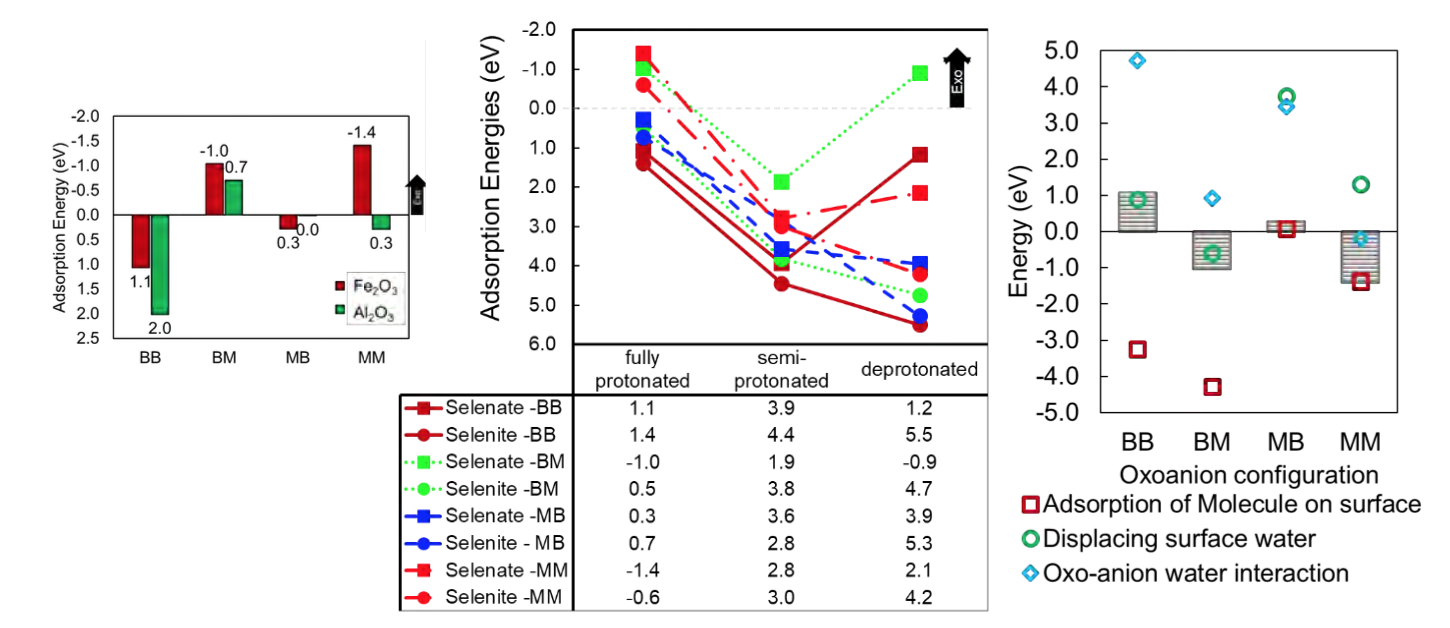Density Functional Theory (DFT) Modeling of Oxo anion Adsorption of Different Metal Oxide Edge Structures
Outcome/Accomplishment
Preliminary research on the sorption of selenium (Se) on nano-hematite indicates that nano-adsorption performance is related to the presence of certain high-energy crystal facets, and the coordination of terminal surface groups in particular. Researchers at Rice University's Nanotechnology Enabled Water Treatment (NEWT) Center – a National Science Foundation Engineering Research Center (NSF ERC) – successfully constructed mold surfaces for density functional theory (DFT) molding of Se oxo anion adsorption onto metal oxides to explore how adsorbents can be designed to selectively remove these contaminants in water systems. A key insight emerging from the work is that the water solvation of both the surface and the oxo anion are critical in understanding adsorption behaviors. This is due both to exothermic displacement that occurs as water and oxide surfaces bind strongly together and to the hydrogen bonding networks that form between the oxo anion and the surface waters which mitigate behavior.
Impact/Benefits
The effective removal of inorganic contaminants from drinking water at Superfund sites is critical to protecting human health. However, this process is challenged by the presence of naturally occurring, health-benign ions that compete for surface adsorption sites in treatment processes, such as adsorbents intended to remove the target metal pollutants. Competitor oxo anions frequently occur at comparable or higher concentrations than water contaminants, exhibit analogous chemical structures, and demonstrate similar or superior affinities for sorption sites. The recent studies at the NEWT Center exploit chemical behavioral differences such as polarity, charge distribution, size, and hydrophobicity between target oxo anion inorganic pollutants and naturally occurring competing ions to generate highly selective and tunable nano surfaces for water processing.
Explanation/Background
Emerging bottom-up design strategies are being applied to develop macro-scale sorbents with improved efficiency and effectiveness over current commercial top-down designed sorbents. And recent advances in nanoscience allow for unprecedented bottom-up capabilities to thermodynamically model, characterize, and controllably synthesize adsorbents.
NEWT researchers sought to develop a fundamental understanding of how different oxo anions competitively sorb to different crystal facets based upon sorption experiments, synchrotron analysis, and parameterization of surface complexation electrostatic and DFT models. Results are being used to computationally model and predict the adsorption behaviors of oxo anions onto metal oxides such as ferric oxide (Fe2O3) and aluminum oxide (Al2O3). With this information available, researchers can better design next-generation nano-structured, highly selective materials for informing sensor development, advancing catalyst design, or directly removing contaminants from aqueous systems.
NEWT's studies focused on a test case system involving arsenite and arsenate sorption on a crystal facet; empirical adsorption experiments and DFT modeling efforts were completed. The surface complexation model and pore diffusion models were developed and linked simultaneously. The team demonstrated varying sorption capacities and affinities for arsenite and arsenate on differing hematite facets. The study spanned comparison of adsorption preferential sites; inclusion of protonation extent; and an initial delineation of interactions effects. Based on this test case, the team successfully coded a MATLAB for a surface complexation model (SCM) for arsenate adsorption that incorporates coulombic interactions (i.e., ionic strength), NP surface area and site density—the intrinsic surface complexation constants that account for strong or weak binding sites (i.e., different crystal facet binding sites). The SCM can predict arsenic adsorption across a range of pH, initial concentration, and ionic strength conditions. It can also be expanded over time to include competing ions.
Location
Houston, Texaswebsite
Start Year
Energy and Sustainability
Energy, Sustainability, and Infrastructure
Lead Institution
Core Partners
Fact Sheet
Outcome/Accomplishment
Preliminary research on the sorption of selenium (Se) on nano-hematite indicates that nano-adsorption performance is related to the presence of certain high-energy crystal facets, and the coordination of terminal surface groups in particular. Researchers at Rice University's Nanotechnology Enabled Water Treatment (NEWT) Center – a National Science Foundation Engineering Research Center (NSF ERC) – successfully constructed mold surfaces for density functional theory (DFT) molding of Se oxo anion adsorption onto metal oxides to explore how adsorbents can be designed to selectively remove these contaminants in water systems. A key insight emerging from the work is that the water solvation of both the surface and the oxo anion are critical in understanding adsorption behaviors. This is due both to exothermic displacement that occurs as water and oxide surfaces bind strongly together and to the hydrogen bonding networks that form between the oxo anion and the surface waters which mitigate behavior.
Location
Houston, Texaswebsite
Start Year
Energy and Sustainability
Energy, Sustainability, and Infrastructure
Lead Institution
Core Partners
Fact Sheet
Impact/benefits
The effective removal of inorganic contaminants from drinking water at Superfund sites is critical to protecting human health. However, this process is challenged by the presence of naturally occurring, health-benign ions that compete for surface adsorption sites in treatment processes, such as adsorbents intended to remove the target metal pollutants. Competitor oxo anions frequently occur at comparable or higher concentrations than water contaminants, exhibit analogous chemical structures, and demonstrate similar or superior affinities for sorption sites. The recent studies at the NEWT Center exploit chemical behavioral differences such as polarity, charge distribution, size, and hydrophobicity between target oxo anion inorganic pollutants and naturally occurring competing ions to generate highly selective and tunable nano surfaces for water processing.
Explanation/Background
Emerging bottom-up design strategies are being applied to develop macro-scale sorbents with improved efficiency and effectiveness over current commercial top-down designed sorbents. And recent advances in nanoscience allow for unprecedented bottom-up capabilities to thermodynamically model, characterize, and controllably synthesize adsorbents.
NEWT researchers sought to develop a fundamental understanding of how different oxo anions competitively sorb to different crystal facets based upon sorption experiments, synchrotron analysis, and parameterization of surface complexation electrostatic and DFT models. Results are being used to computationally model and predict the adsorption behaviors of oxo anions onto metal oxides such as ferric oxide (Fe2O3) and aluminum oxide (Al2O3). With this information available, researchers can better design next-generation nano-structured, highly selective materials for informing sensor development, advancing catalyst design, or directly removing contaminants from aqueous systems.
NEWT's studies focused on a test case system involving arsenite and arsenate sorption on a crystal facet; empirical adsorption experiments and DFT modeling efforts were completed. The surface complexation model and pore diffusion models were developed and linked simultaneously. The team demonstrated varying sorption capacities and affinities for arsenite and arsenate on differing hematite facets. The study spanned comparison of adsorption preferential sites; inclusion of protonation extent; and an initial delineation of interactions effects. Based on this test case, the team successfully coded a MATLAB for a surface complexation model (SCM) for arsenate adsorption that incorporates coulombic interactions (i.e., ionic strength), NP surface area and site density—the intrinsic surface complexation constants that account for strong or weak binding sites (i.e., different crystal facet binding sites). The SCM can predict arsenic adsorption across a range of pH, initial concentration, and ionic strength conditions. It can also be expanded over time to include competing ions.

